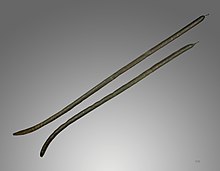Cash desks
| Cash desks | ||||||||||||
|---|---|---|---|---|---|---|---|---|---|---|---|---|

Tube cassia ( Cassia fistula ) |
||||||||||||
| Systematics | ||||||||||||
|
||||||||||||
| Scientific name | ||||||||||||
| Cassia | ||||||||||||
| L. |
The Kassien ( Cassia ) are a genus in the subfamily Caesalpinioideae within the family of legumes (Fabaceae).
description


Vegetative characteristics
Cassia species grow as small, unreinforced trees or large shrubs . The above-ground parts of the plant are hairy or bare.
The alternate or spiraling, stalked leaves are glandless and pinnate in pairs with 3 to 25 pairs of leaflets . The entire-margined and short-stalked leaflets are ovate to obovate or elliptical and rounded to pointed and sometimes indented. The leaflets are pale green underneath. The sometimes bilobed stipules are pointed and deciduous.
Generative characteristics
The flowers stand together in terminal racemose inflorescences .
The five-fold flowers are slightly zygomorphic and petiolate. The five sepals are approximately the same, obovate and green to yellowish. The five petals are yellow or pink or rarely reddish, also white and mixed colors. They have a bract and bracte which usually fall off early.
There are ten free stamens or staminodes . The stamens are uneven and arranged in two circles. The three adaxial are much smaller and mostly sterile (staminodes), the four middle ones are longer and the three abaxial are very elongated, sigmoidal or S-shaped, with long anthers and the stamens are sometimes a little puffed up. The anthers are different, but never beaked. The stamens and staminodes open basal porizd and / or ventricid.
The above constant, stalked, elongated and unilocular ovary is hook-shaped curved and longer than the petals, it has many ovules and a barely distinctive, short pen capitate with a small scar .
The pendulous and short-stalked legumes are cylindrical or flattened and woody and rarely winged. They usually do not open up to maturity. Between the seeds there are more or less developed, transverse partitions (septa) that grow up in the endocarp . The very hard seeds are usually embedded in a soft pulp that tastes sweet to bitter and is more or less sticky. The funiculus of the seed, with which they are attached to the pericarp, is thread-shaped.
Systematics and distribution
The genus Cassia is pantropical .
The genus Cassia was established by Carl von Linné in 1753 . Synonyms for Cassia L. are: Bactyrilobium Willd. , Cathartocarpus pers.
The genus Cassia belongs to the subtribe Cassiinae in the tribe Cassieae in the subfamily Caesalpinioideae within the family of legumes (Fabaceae). Today the genus includes about 30 to over 70 species. In the past, the genus was much more species-rich, but a large part of the species was separated into the genera Senna Mill. And Chamaecrista Moench .
List of accepted cassia species:
Web links
- Description of the genre in the larger / old scope at DELTA.
- Cassia at Tropicos.org. In: Flora Mesoamericana . Missouri Botanical Garden, St. Louis
- Cassia at Tropicos.org. In: Peru Checklist . Missouri Botanical Garden, St. Louis
- Cassia at Tropicos.org. In: Flora of Panama (WFO) . Missouri Botanical Garden, St. Louis
- Cassia at Tropicos.org. In: IPCN Chromosome Reports . Missouri Botanical Garden, St. Louis
Receipts and individual evidence
- BR Randell, BA Barlow: Cassia , In: Flora of Australia , Volume 12, 1998. (online)
- ↑ Monographs Details: Cassia at New York Botanical Garden, accessed August 7, 2018.
- ↑ a b c Cassia at Tropicos.org. In: Flora de Nicaragua . Missouri Botanical Garden, St. Louis
- ^ Linnaeus scanned in at biodiversitylibrary.org in 1753 .
- ^ Cassia at Tropicos.org. Missouri Botanical Garden, St. Louis, accessed November 20, 2015.
- ^ A b c Cassia in the Germplasm Resources Information Network (GRIN), USDA , ARS , National Genetic Resources Program. National Germplasm Resources Laboratory, Beltsville, Maryland.
- ↑ Data sheet at International Legume Database Information Service = ILDIS - LegumeWeb - World Database of Legumes , Version 10.38 from July 20, 2010.
- ^ Cassia at Tropicos.org. In: Flora of Pakistan . Missouri Botanical Garden, St. Louis
- ^ Cassia at Tropicos.org. In: Catalog of the Vascular Plants of Madagascar . Missouri Botanical Garden, St. Louis







